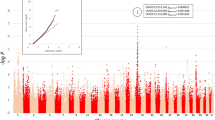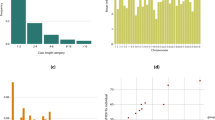Abstract
With several hundred genetic diseases and an advantageous genome structure, dogs are ideal for mapping genes that cause disease. Here we report the development of a genotyping array with ∼27,000 SNPs and show that genome-wide association mapping of mendelian traits in dog breeds can be achieved with only ∼20 dogs. Specifically, we map two traits with mendelian inheritance: the major white spotting (S) locus and the hair ridge in Rhodesian ridgebacks. For both traits, we map the loci to discrete regions of <1 Mb. Fine-mapping of the S locus in two breeds refines the localization to a region of ∼100 kb contained within the pigmentation-related gene MITF. Complete sequencing of the white and solid haplotypes identifies candidate regulatory mutations in the melanocyte-specific promoter of MITF. Our results show that genome-wide association mapping within dog breeds, followed by fine-mapping across multiple breeds, will be highly efficient and generally applicable to trait mapping, providing insights into canine and human health.
This is a preview of subscription content, access via your institution
Access options
Subscribe to this journal
Receive 12 print issues and online access
$209.00 per year
only $17.42 per issue
Buy this article
- Purchase on Springer Link
- Instant access to full article PDF
Prices may be subject to local taxes which are calculated during checkout




Similar content being viewed by others
References
Lindblad-Toh, K. et al. Genome sequence, comparative analysis and haplotype structure of the domestic dog. Nature 438, 803–819 (2005).
Sutter, N.B. et al. Extensive and breed-specific linkage disequilibrium in Canis familiaris. Genome Res. 14, 2388–2396 (2004).
Wade, C.M., Karlsson, E.K., Mikkelsen, T.S., Zody, M.C. & Lindblad-Toh, K. The dog genome: sequence, evolution and haplotype structure. in The Dog and Its Genome (eds. Ostrander, E.A., Giger, U. & Lindblad-Toh, K.) 179–207 (Cold Spring Harbor Laboratory Press, Cold Spring Harbor, NY, 2006).
Hartl, D.L. & Clark, A.G. Principles of Population Genetics (Sinauer Associates, Sunderland, MA, 2007).
Keinan, A., Mullikin, J.C., Patterson, N. & Reich, D. Measurement of the human allele frequency spectrum demonstrates greater genetic drift in East Asians than in Europeans. Nat. Genet. 39, 1251–1255 (2007).
Parker, H.G. et al. Genetic structure of the purebred domestic dog. Science 304, 1160–1164 (2004).
Patterson, N., Price, A.L. & Reich, D. Population structure and eigenanalysis. PLoS Genet. 2, e190 (2006).
Hillbertz, N.H. & Andersson, G. Autosomal dominant mutation causing the dorsal ridge predisposes for dermoid sinus in Rhodesian ridgeback dogs. J. Small Anim. Pract. 47, 184–188 (2006).
Copp, A.J., Greene, N.D. & Murdoch, J.N. The genetic basis of mammalian neurulation. Nat. Rev. Genet. 4, 784–793 (2003).
Purcell, S. et al. PLINK: a tool set for whole-genome association and population-based linkage analyses. Am. J. Hum. Genet. 81, 559–575 (2007).
Karabagli, H., Karabagli, P., Ladher, R.K. & Schoenwolf, G.C. Comparison of the expression patterns of several fibroblast growth factors during chick gastrulation and neurulation. Anat. Embryol. (Berl.) 205, 365–370 (2002).
Ladher, R.K., Wright, T.J., Moon, A.M., Mansour, S.L. & Schoenwolf, G.C. FGF8 initiates inner ear induction in chick and mouse. Genes Dev. 19, 603–613 (2005).
Salmon Hillbertz, N.H.C. et al. A duplication of FGF3, FGF4, FGF19 and ORAOV1 causes hair ridge and predisposition to dermoid sinus in Ridgeback dogs. Nat. Genet. advance online publication 30 September 2007 (doi:10:1038/ng.2007.4).
Dourmishev, A.L., Dourmishev, L.A., Schwartz, R.A. & Janniger, C.K. Waardenburg syndrome. Int. J. Dermatol. 38, 656–663 (1999).
Tietz, W. A syndrome of deaf-mutism associated with albinism showing dominant autosomal inheritance. Am. J. Hum. Genet. 15, 259–264 (1963).
Little, C.C. The Inheritance of Coat Color in Dogs (Comstock Publishing Associates, Ithaca, NY, 1957).
Metallinos, D. & Rine, J. Exclusion of EDNRB and KIT as the basis for white spotting in Border Collies. Genome Biol. 1 research0004.1–research0004.4 (2000).
van Hagen, M.A. et al. Analysis of the inheritance of white spotting and the evaluation of KIT and EDNRB as spotting loci in Dutch boxer dogs. J. Hered. 95, 526–531 (2004).
Smith, S.D., Kelley, P.M., Kenyon, J.B. & Hoover, D. Tietz syndrome (hypopigmentation/deafness) caused by mutation of MITF. J. Med. Genet. 37, 446–448 (2000).
Tassabehji, M., Newton, V.E. & Read, A.P. Waardenburg syndrome type 2 caused by mutations in the human microphthalmia (MITF) gene. Nat. Genet. 8, 251–255 (1994).
Steingrimsson, E., Copeland, N.G. & Jenkins, N.A. Melanocytes and the microphthalmia transcription factor network. Annu. Rev. Genet. 38, 365–411 (2004).
Widlund, H.R. & Fisher, D.E. Microphthalamia-associated transcription factor: a critical regulator of pigment cell development and survival. Oncogene 22, 3035–3041 (2003).
Levy, C., Khaled, M. & Fisher, D.E. MITF: master regulator of melanocyte development and melanoma oncogene. Trends Mol. Med. 12, 406–414 (2006).
Saito, H. et al. Melanocyte-specific microphthalmia-associated transcription factor isoform activates its own gene promoter through physical interaction with lymphoid-enhancing factor 1. J. Biol. Chem. 277, 28787–28794 (2002).
Jacquemin, P. et al. The transcription factor onecut-2 controls the microphthalmia-associated transcription factor gene. Biochem. Biophys. Res. Commun. 285, 1200–1205 (2001).
Bondurand, N. et al. Interaction among SOX10, PAX3 and MITF, three genes altered in Waardenburg syndrome. Hum. Mol. Genet. 9, 1907–1917 (2000).
Udono, T. et al. Structural organization of the human microphthalmia-associated transcription factor gene containing four alternative promoters. Biochim. Biophys. Acta 1491, 205–219 (2000).
Burns, M. & Fraser, M.N. Genetics of the Dog: the Basis of Successful Breeding (Oliver & Boyd, Edinburgh, London, 1966).
Motohashi, H., Hozawa, K., Oshima, T., Takeuchi, T. & Takasaka, T. Dysgenesis of melanocytes and cochlear dysfunction in mutant microphthalmia (mi) mice. Hear. Res. 80, 10–20 (1994).
Yoshida, H., Kunisada, T., Kusakabe, M., Nishikawa, S. & Nishikawa, S.I. Distinct stages of melanocyte differentiation revealed by analysis of nonuniform pigmentation patterns. Development 122, 1207–1214 (1996).
Strain, G.M. Deafness prevalence and pigmentation and gender associations in dog breeds at risk. Vet. J. 167, 23–32 (2004).
Jordan, S.A. & Jackson, I.J. A late wave of melanoblast differentiation and rostrocaudal migration revealed in patch and rump-white embryos. Mech. Dev. 92, 135–143 (2000).
Barrett, J.C., Fry, B., Maller, J. & Daly, M.J. Haploview: analysis and visualization of LD and haplotype maps. Bioinformatics 21, 263–265 (2005).
Price, A.L. et al. Principal components analysis corrects for stratification in genome-wide association studies. Nat. Genet. 38, 904–909 (2006).
Felsenstein, J. PHYLIP, phylogeny inference package (version 3.2). Cladistics 5, 164–166 (1989).
Karolchik, D. et al. The UCSC Genome Browser Database. Nucleic Acids Res. 31, 51–54 (2003).
Acknowledgements
We thank the Genetic Analysis Platform at the Broad Institute of MIT and Harvard for performing the SNP array genotyping, and L. Gaffney for assistance with figures. The work was supported by the AKC/Canine Health Foundation (grant 373), the Foundation for Strategic Research, and the Donald and Jo Ann Petersen Endowed Research Fund of the University of Michigan Comprehensive Cancer Center.
Author information
Authors and Affiliations
Corresponding authors
Supplementary information
Supplementary Text and Figures
Supp Tables 1–3, Supp Figures 1–4, Supp Methods (PDF 4574 kb)
Rights and permissions
About this article
Cite this article
Karlsson, E., Baranowska, I., Wade, C. et al. Efficient mapping of mendelian traits in dogs through genome-wide association. Nat Genet 39, 1321–1328 (2007). https://doi.org/10.1038/ng.2007.10
Received:
Accepted:
Published:
Issue Date:
DOI: https://doi.org/10.1038/ng.2007.10



